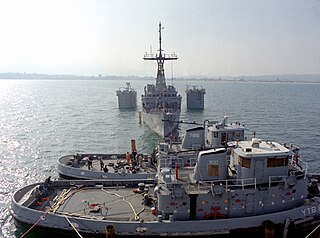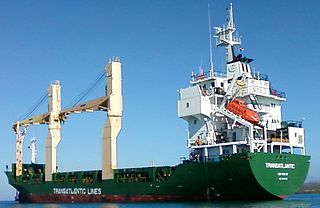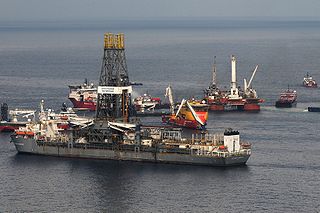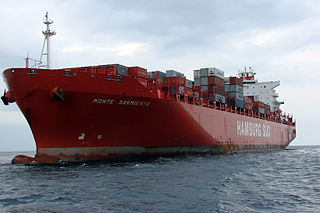| History | |
|---|---|
| Name: |
|
| Owner: | Sealion Shipping Ltd. |
| Port of registry: | |
| Ordered: | October 19, 1995 |
| Builder: | Ulstein Verft, Norway |
| Laid down: | April 30, 1996 |
| Launched: | January 10, 1997 |
| Acquired: | March 1, 1997 |
| Identification: |
|
| Notes: | [1] |
| General characteristics | |
| Class and type: |
|
| Tonnage: | |
| Length: | 103.65 m (340.1 ft) |
| Beam: | 23.2 m (76 ft) |
| Draught: | 7.065 m (23.18 ft) |
| Depth: | 9 m (30 ft) |
| Installed power: | 10,875 kW |
| Propulsion: |
|
| Speed: | 12 kn (22 km/h; 14 mph) |
| Capacity: |
|
| Notes: | [2] |
Toisa Pisces is a Liberia-flagged well test and servicing vessel owned and operated by Sealion Shipping Ltd. She is classified by Det Norske Veritas as an oil production and storage unit. [1]

Liberia, officially the Republic of Liberia, is a country on the West African coast. It is bordered by Sierra Leone to its northwest, Guinea to its north, Ivory Coast to its east, and the Atlantic Ocean to its south-southwest. It covers an area of 111,369 square kilometers (43,000 sq mi) and has a population of around 4,700,000 people. English is the official language and over 20 indigenous languages are spoken, representing the numerous ethnic groups who make up more than 95% of the population. The country's capital and largest city is Monrovia.

Flag of convenience (FOC) is a business practice whereby a ship's owners register a merchant ship in a ship register of a country other than that of the ship's owners, and the ship flies the civil ensign of that country, called the flag state. The term is often used pejoratively, and the practice is regarded as contentious. Each merchant ship is required by international law to be registered in a registry created by a country, and a ship is subject to the laws of that country, which are used also if the ship is involved in a case under admiralty law. A ship's owners may elect to register a ship in a foreign country which enables it to avoid the regulations of the owners’ country which may, for example, have stricter safety standards. They may also select a jurisdiction to reduce operating costs, bypassing laws that protect the wages and working conditions of mariners. The term "flag of convenience" has been used since the 1950s. A registry which does not have a nationality or residency requirement for ship registration is often described as an open registry. Panama, for example, offers the advantages of easier registration and the ability to employ cheaper foreign labour. Furthermore the foreign owners pay no income taxes.
Sealion Shipping Limited is a British shipping and consultancy company specialized on the support of the offshore oil and gas industry. The company was established in January 1975. In 1982, Sealion expanded its activities into the support of the offshore oil and gas industry. It operates the Toisa fleet of 25 various types of offshore vessels, including well test and servicing vessel Toisa Pisces.
Toisa Pisces was built in 1997 by Ulstein Verft in Norway as a drilling platform supplier and cable ship. [1] [3] In 1997–2000 she was owned and operated by France Câbles et Radio under the name of Fresnel and under the flag of France. In 2000–2003 she was owned by FT Marine SAS. [1] In 2003, the ship was purchased by Sealion Shipping and it was converted at the Gdańsk Shipyard as oil processing unit. [1] [3] She was renamed Toisa Pisces and registered in Monrovia, Liberia. [1] She has an oil processing capacity up to 20,000 barrels per day (3,200 m3/d). [4]

Ulstein Group is a group of companies that focus on various marine-related industries, but is mainly known for its ship building and ship design activities. The largest unit is Ulstein Verft AS. One recent delivery was the Service Operation Vessel 'Windea La Cour' (2016) which is operating at offshore wind farms offshore The Netherlands, the first vessel with not only the inverted bow, X-BOW, but also the X-STERN hull design shapes. The ship design unit, Ulstein Design & Solutions AS came up with the X-BOW design that in the shape of Bourbon Orca delivered in 2006 won the Ship of The Year Award both by Skipsrevyen and Offshore Support Journal. The group also includes companies working with power & control, system solutions and handling equipment for vessels servicing the maritime industries, including offshore renewables, offshore oil & gas, cruise and RoPax. Lately, the company has also been engaged in shipping. The company's head office and primary operations are located in the town of Ulsteinvik in the municipality of Ulstein in Møre og Romsdal county, Norway, an important area for the Norwegian maritime cluster, and with subsidiaries in several other countries.

Norway, officially the Kingdom of Norway, is a Nordic country in Northwestern Europe whose territory comprises the western and northernmost portion of the Scandinavian Peninsula; the remote island of Jan Mayen and the archipelago of Svalbard are also part of the Kingdom of Norway. The Antarctic Peter I Island and the sub-Antarctic Bouvet Island are dependent territories and thus not considered part of the kingdom. Norway also lays claim to a section of Antarctica known as Queen Maud Land.

A cable layer or cable ship is a deep-sea vessel designed and used to lay underwater cables for telecommunications, electric power transmission, or other purposes. Cable ships are distinguished by large cable sheaves for guiding cable over bow or stern or both. Bow sheaves, some very large, were characteristic of all cable ships in the past, but newer ships are tending toward having stern sheaves only, as seen in the photo of CS Cable Innovator at the Port of Astoria on this page. The names of cable ships are often preceded by "C.S." as in CS Long Lines.















